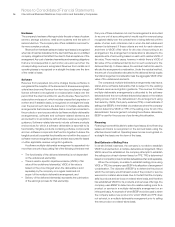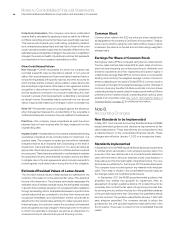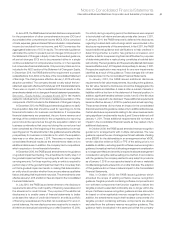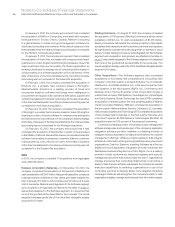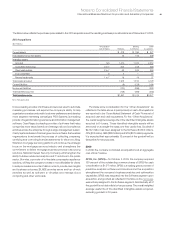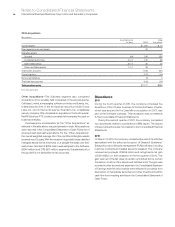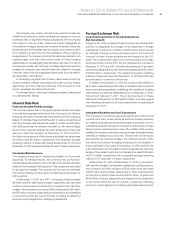IBM 2011 Annual Report Download - page 89
Download and view the complete annual report
Please find page 89 of the 2011 IBM annual report below. You can navigate through the pages in the report by either clicking on the pages listed below, or by using the keyword search tool below to find specific information within the annual report.
Notes to Consolidated Financial Statements
International Business Machines Corporation and Subsidiary Companies 87
In June 2011, the FASB issued amended disclosure requirements
for the presentation of other comprehensive income (OCI) and
accumulated other comprehensive income (AOCI). OCI is comprised
of costs, expenses, gains and losses that are included in comprehensive
income but excluded from net income, and AOCI comprises the
aggregated balances of OCI in equity. The amended guidance
eliminated the option to present period changes (OCI) as part of
the Statement of Changes in Equity. Under the amended guidance,
all period changes (OCI) are to be presented either in a single
continuous statement of comprehensive income, or in two separate
but consecutive financial statements. Only summary totals are to be
included in the AOCI section of the Statement of Changes in Equity.
In December 2011, the FASB deferred the requirement to present
reclassifications from AOCI on the face of the Consolidated Statement
of Earnings. The changes were effective January 1, 2012 with early
adoption permitted. The company elected to early adopt the two-
statement approach effective with its full year 2011 financial statements.
There was no impact in the consolidated financial results as the
amendments related only to changes in financial statement presentation.
See note L, “Equity Activity,” on pages 110 and 112 for tax impacts
related to individual items of OCI and a detailed presentation of the
components of AOCI included in the Statement of Changes in Equity.
In December 2010, the FASB issued amended guidance to clarify
the acquisition date that should be used for reporting pro-forma
financial information for business combinations. If comparative
financial statements are presented, the pro-forma revenue and
earnings of the combined entity for the comparable prior reporting
period should be reported as though the acquisition date for all
business combinations that occurred during the current year had
been completed as of the beginning of the comparable prior annual
reporting period. The amendments in this guidance became effective
prospectively for business combinations for which the acquisition
date was on or after January 1, 2011. There was no impact in the
consolidated financial results as the amendments relate only to
additional disclosures. In addition, the company had no acquisitions
which required pro-forma financial information.
In December 2010, the FASB issued amendments to the guidance
on goodwill impairment testing. The amendments modify step 1 of
the goodwill impairment test for reporting units with zero or negative
carrying amounts. For those reporting units, an entity is required to
perform step 2 of the goodwill impairment test if it is more likely than
not that a goodwill impairment exists. In making that determination,
an entity should consider whether there are any adverse qualitative
factors indicating that impairment may exist. The amendments were
effective January 1, 2011 and did not have an impact in the Consolidated
Financial Statements.
In July 2010, the FASB issued amendments to the disclosure
requirements about the credit quality of financing receivables and
the allowance for credit losses. The purpose of the additional
disclosures is to enable users of financial statements to better
understand the nature of credit risk inherent in an entity’s portfolio
of financing receivables and how that risk is analyzed. For end-of-
period balances, the new disclosures were required to be made in
all interim and annual periods ending on or after December 15, 2010.
For activity during a reporting period, the disclosures were required
to be included in all interim and annual periods after January 1, 2011.
In January 2011, the FASB temporarily deferred the disclosures
regarding troubled debt restructurings which were included in the
disclosure requirements of this amendment. In April 2011, the FASB
issued additional guidance and clarifications to help creditors in
determining whether a creditor has granted a concession, and
whether a debtor is experiencing financial difficulties for purposes
of determining whether a restructuring constitutes a troubled debt
restructuring. The new guidance and the previously deferred disclosures
became effective July 1, 2011 applied retrospectively to January 1, 2011.
Prospective application was required for any new impairments
identified as a result of this guidance. These changes did not have
a material impact in the Consolidated Financial Statements.
In January 2010, the FASB issued additional disclosure
requirements for fair value measurements. According to the guidance,
the fair value hierarchy disclosures should be disaggregated by
class of assets and liabilities. A class is often a subset of assets or
liabilities within a line item in the statement of financial position. In
addition, significant transfers between Levels 1 and 2 of the fair value
hierarchy are required to be disclosed. These additional requirements
became effective January 1, 2010 for quarterly and annual reporting.
These amendments did not have an impact in the consolidated
financial results as this guidance relates only to additional disclosures.
Certain disclosure requirements relating to fair value measurements
using significant unobservable inputs (Level 3) were deferred until
January 1, 2011. These additional requirements did not have an
impact in the consolidated financial results as they related only to
additional disclosures.
In October 2009, the FASB issued amended revenue recognition
guidance for arrangements with multiple deliverables. The new
guidance requires the use of management’s best estimate of selling
price (BESP) for the deliverables in an arrangement when VSOE,
vendor objective evidence (VOE) or TPE of the selling price is not
available. In addition, excluding specific software revenue recognition
guidance, the residual method of allocating arrangement consideration
is no longer permitted, and an entity is required to allocate arrangement
consideration using the relative selling price method. In accordance
with the guidance, the company elected to early adopt its provisions
as of January 1, 2010 on a prospective basis for all new or materially
modified arrangements entered into on or after that date. The adoption
of this guidance did not have a material impact in the Consolidated
Financial Statements.
Also, in October 2009, the FASB issued guidance which
amended the scope of existing software revenue recognition
guidance. Tangible products containing software components and
non-software components that function together to deliver the
tangible product’s essential functionality are no longer within the
scope of software revenue recognition guidance and are accounted
for based on other applicable revenue recognition guidance. In
addition, the amendments require that hardware components of a
tangible product containing software components are always
excluded from the software revenue recognition guidance. This
guidance had to be adopted in the same period that the company



